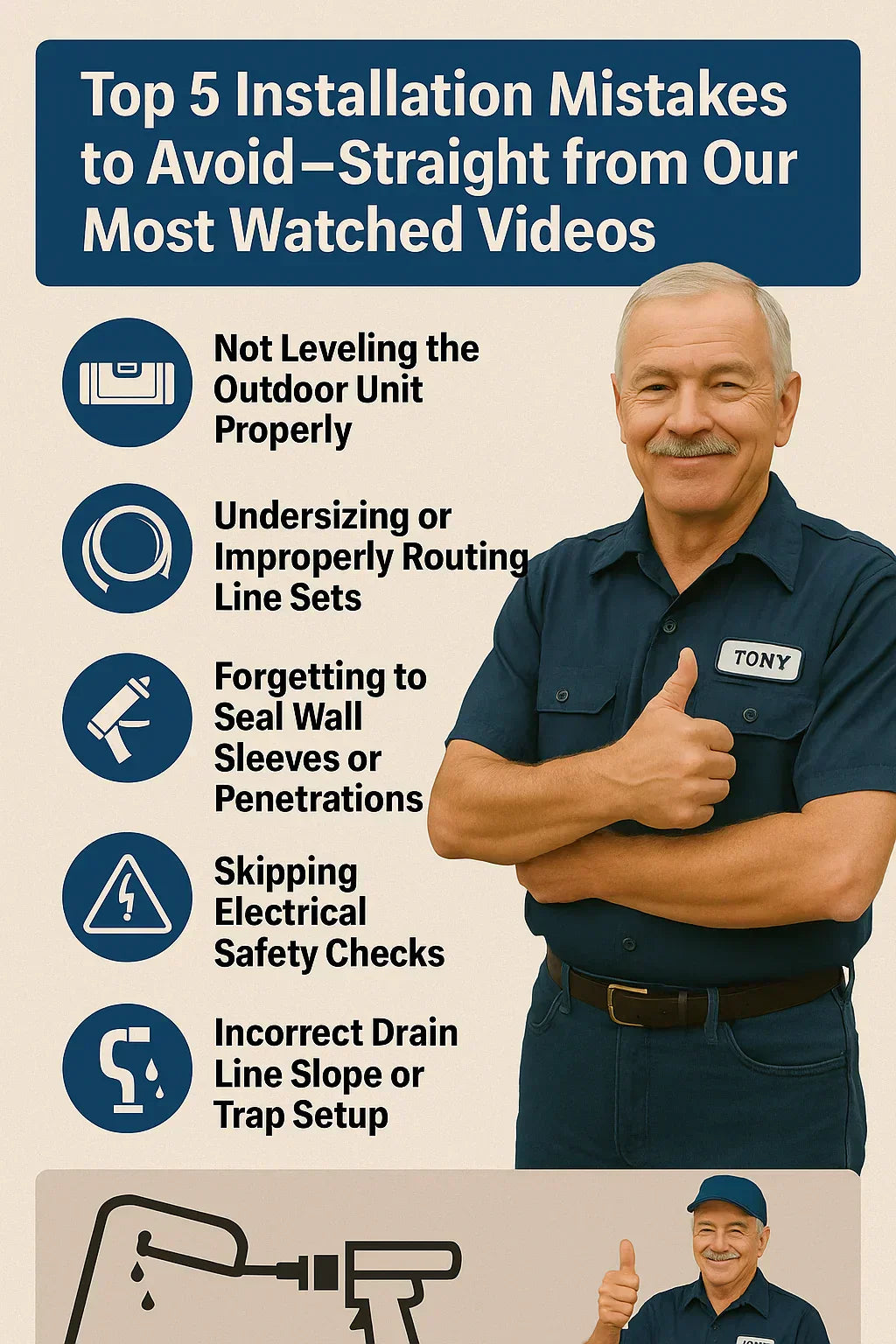1. 📐 Mistake #1: Not Leveling the Outdoor Unit Properly
Why Tony Should Care
An unlevel condenser or outdoor mini‑split pad can lead to oil return issues, compressor wear, vibration noise, and premature failure. Visuals in our videos show units tilting over time due to uneven base installation — a costlier problem down the line.
What Our Videos Show
-
Outdoor units installed on uneven ground
-
Technicians adjusting shims under pads to ensure perfect level
-
Demonstrations of using a torpedo level before bolting the unit in place
Tony's Game Plan
-
Prepare a solid, level base: Concrete pad or stacking composite pads
-
Check the level front-to-back and side-to-side, using a 48″ level
-
Shim or relevel before installing the unit – don’t wait until after refrigerant is hooked up
✅ Benefit: Quiet, vibration-free operation and longer system life
2. 💧 Mistake #2: Undersizing or Improperly Routing Line Sets
Why It Matters
Line sets longer than manufacturer guidelines or bent/kinked can cause refrigerant pressure loss, reduced efficiency, and freeze-ups.
What Our Videos Show
-
Persistent kinks in hard-line tubing that restrict flow
-
Long, unsupported line runs failing to conform to the manufacturer’s max length rules
-
Proper routing through wall grommets, UV‑protected conduit, and support straps
Tony's Game Plan
-
Calculate and pre-measure the run, and compare with spec limits
-
Use support within 4 ft of the indoor & outdoor unit connections
-
Install UV-resistant insulation and secure lines neatly
✅ Result: Consistent performance, better SEER, and lower risk of refrigerant leaks
3. 🛡️ Mistake #3: Forgetting to Seal Wall Sleeves or Penetrations
Why Sealing Is Critical
Unsealed sleeves create entry points for pests, drafts, and moisture — and lower energy efficiency.
What the Videos Demonstrate
-
PTAC and through-wall units installed without foam gasket, later showing air leakage
-
Fixes using foam backer rod, silicone, and proper trim rings from both exterior and interior angles
Tony's Game Plan
-
Choose the right-sized sleeve for a precise fit
-
Apply foam backer rod and exterior-grade silicone from inside
-
Finish with trim rings or A/C sleeves for airtight sealing
✅ Benefit: Improved energy efficiency and a cleaner install
4. ⚡ Mistake #4: Skipping Electrical Safety Checks
The Electrical Risk
Wrong wire gauge, incorrect breakers, or no disconnect box can cause system trip-outs, short cycling, blown fuse, or even fire hazards.
What We Show in the Videos
-
Installers reading the unit’s nameplate for wire size and breaker rating
-
Proper installation of disconnects adjacent to outdoor units
-
Grounding and making fuse panels visible and accessible
Tony's Game Plan
-
Match wire gauge to circuit ampacity per unit nameplate
-
Use a correctly rated fuse or breaker in the outdoor disconnect
-
Test and confirm voltage, polarity, and grounding before powering on
✅ Result: Safe operation and alignment with NEC code
5. 🚰 Mistake #5: Incorrect Drain Line Slope or Trap Setup
Drainage Done Right
Poorly designed condensate drains cause backups, mold growth, unit shutdowns, and water damage.
Video Examples
-
Witnessing water backup in visual walkthroughs
-
Demonstrations of using traps or vertical "P" loops where required
-
Showing clean-out tees near drain feeds for future maintenance
Tony's Game Plan
-
Ensure ¼″ downward slope per foot of horizontal run
-
Include a trap if required by your system’s design
-
Install a cleanout at the lowest point for easy maintenance
✅ Benefit: Reliable drainage, less maintenance, and fewer callbacks
🔍 Why These Videos Are So Effective for Tony
-
Real installs: Not staged; they show both successes and fixes
-
Time‑stamped guidance: See exactly where the angle gets off or the level is off
-
Follow‑along narration: Installers explain the “why” as well as the “how”
Tony sees other people make mistakes and learns faster than from a manual alone.
🧰 Tony’s Pre‑Install Cheat Sheet
| Step | Task | Video Tips to Watch |
|---|---|---|
| 1 | Level base for outdoor unit | Watch pad placement and use of leveling tools |
| 2 | Measure and route line sets | Observe supports and no-kink routing |
| 3 | Seal everything properly | Fans of foam rod + silicone finishes |
| 4 | Set up electrical disconnect box & connections | Grounding and fuses explained |
| 5 | Install and slope drain line correctly | Look for sags and trap placement |
Tony can hit play, pause, rewind—and install like a pro.
🔗 External References & Industry Advice
-
Energy.gov HVAC Installation Guide – Highlights importance of correct pad level and routing (Common HVAC Installation Mistakes To Avoid)
-
Pioneer Mini‑Split Mistakes – Common errors: improper sealing, wrong sizing The Spruce
-
Jerry’s Heat & Cool – Refrigerant piping overrun issues and cooling impact Jerry's Heat & Cool
-
HVACR Land – Vents & airflow placement errors in central AC perm performance HVACR Land
-
Thespruce.com – Real-world DIY mistakes: air-flow and condenser neglect (7 Mistakes We're All Making With Our Heating and Cooling Systems, HVAC Pros Say)
-
EfficientMiniSplits – Frequent mini‑split install errors & best practices (Top 10 Mistakes to Avoid When Installing a Mini Split AC System)
🎯 Final Takeaways for Tony
-
These are the Top 5 visible pitfalls spotted in our most-watched videos
-
Tony can avoid costly errors by watching, pausing, rewinding at key moments
-
Each mistake comes with a clear video-based workaround
-
Following the cheat sheet means a smooth, professional-level install
With visual walkthroughs guiding Tony, he installs with precision confidence, ensures long-term system efficiency, and saves time—and money—on callbacks.
In the next topic we will know more about: How to Size Your System Using Only a Tape Measure and Our Video Guides







